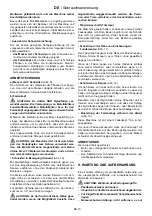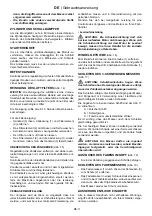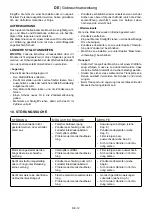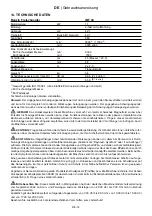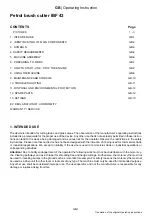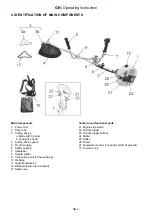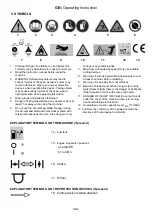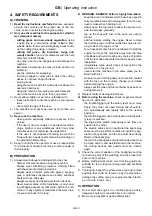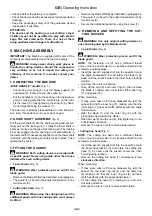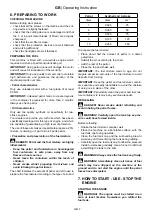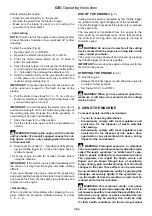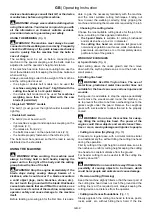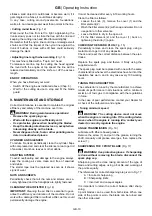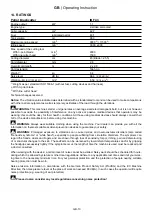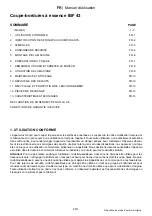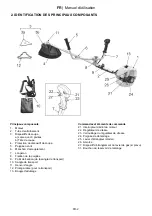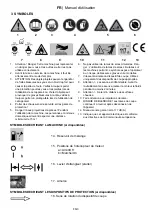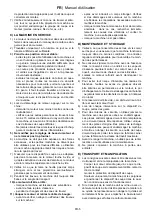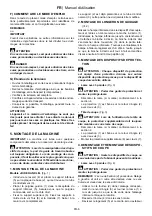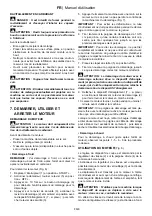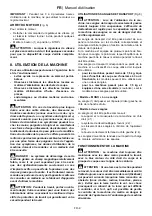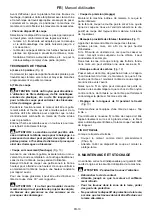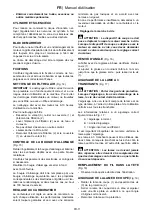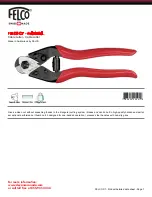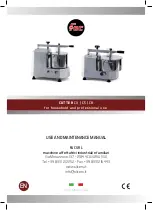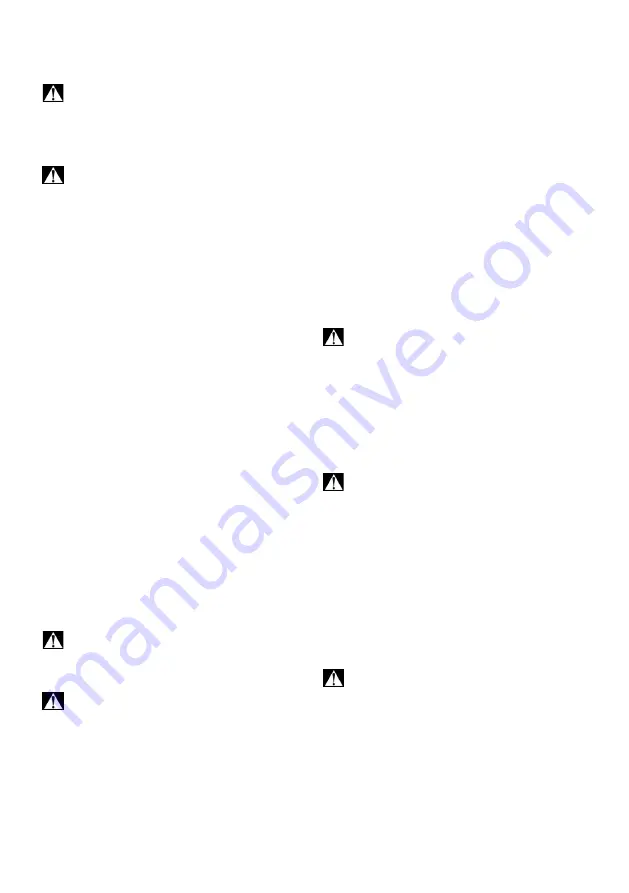
GB
|
Operating Instruction
devices should always consult their GP, or the device
manufacturer, before using this machine.
WARNING!
Always wear suitable clothing when
using the machine. Your dealer can provide you with
all the information on themost suitable accident-
prevention devices to guarantee your safety.
USING THE WEBBING
(Fig. 8)
WARNING!
The machine must always be used
connected to the webbing worn correctly. Frequently
check the efficiency of the quick release mechanism
used to quickly free the machine from the belts in
case of danger.
The webbing must be put on before connecting the
machine to the special coupling and the belts must be
adjusted to suit the operator’s height and stature.
If the machine has more than one coupling hole, use the
most favourable point for keeping the machine balanced
when working.
Always use webbing suited to the weight of the machine
and the cutting device used
-
the single or double belt models can be used
for
machines weighing less than 7.5 kg fitted with the
cutting line head or 3 or 4-point blades;
-
the double belt model must be used
for machines
weighing more than 7.5 kg fitted with the saw
blade (if permitted).
• Single belt “MONO” models
The belt (1) must go over the right shoulder towards the
right hip.
• Double belt models
The belt (2) must be worn with:
-
the machine‘s support and snap-hook coupling on the
right side (2.1);
-
the release in front (2.2);
-
the belts cross-over on the operator‘s back (2.3);
-
the buckle properly fastened on the left side (2.4).
The belts must be tensioned so that the load is evenly
distributed on the shoulders.
USING THE MACHINE
WARNING!
When working, the machine must
always be firmly held in both hands, keeping the
power unit on the right of the body and the cutting
group below the line of the belt.
WARNING!
Stop the engine immediately if the
blade stops during sawing. Always beware of a
kickback, which could occur if a blade encounters
a solid object (logs, roots, branches, stones, etc.).
Do not touch the ground with the blade. Kickbacks
cause blade recoils that are difficult to control, so as
to cause loss of control of the machine, compromise
operator safety and cause damage to the machine
itself.
Before tackling a mowing job for the first time it is advis
-
able to gain the necessary familiarity with the machine
and the most suitable cutting techniques, finding out
how to wear the webbing correctly, firmly gripping the
machine and making the movements required by the job.
• Choosing the cutting device
Choose the most suitable cutting device for the job to be
done, according to these general indications:
- the 3-point blade
is suitable for cutting brushwood
and small shrubs up to 2 cm in diameter;
- the cutting line head
can eliminate tall grass and
non-woody vegetation near fences, walls, foundations,
pavements, around trees, etc. or to completely clean a
particular area of the garden;
WORKING TECHNIQUES
a) 3-point blade
(Fig. 9)
Start cutting above the under growth and then move
down with the scything blade so as to cut the brush into
small pieces.
b) Cutting line head
WARNING!
Use ONLY nylon lines. The use of
metal lines, plasticised metal lines and/or lines not
suitable for the head can cause serious injuries and
wounds.
During use it is advisable to stop the engine periodically
and remove the weeds wound round the machine, so
as to prevent the drive tube from overheating due to the
grass caught under the guard. Remove the caught-up
grass with a screwdriver to allow the rod to be properly
cooled.
WARNING!
Do not use the machine for sweep-
ing, tilting the cutting line head. The power of the
engine could throw objects and small stones 15me-
tres or more, causing damage and injuries to people.
• Cutting in motion (Scything)
(Fig. 10)
Proceed at a regular pace, with a circular motion similar
to a traditional scythe, without tilting the cutting line head
during the operation.
First try cutting at the right height in a small area, so as to
then achieve a uniform cutting height keeping the cutting
line head at a constant distance from the ground.
For heavier cutting it can be useful to tilt the cutting line
head by about 30°.
WARNING!
Do not work in this way if there is the
possibility of causing objects to be thrown, which
could harm people and animals and cause damage.
• Precision cutting (Trimming)
Keep the machine slightly tilted so that the lower part of
the cutting line head does not touch the ground and the
cutting line is at the required point, always keeping the
cutting device at a distance from the operator.
• Cutting near fences/foundations
(Fig. 11)
Slowly approach the cutting line head to fences, posts,
rocks, walls, etc. without hitting them hard. If the line
GB-9
Summary of Contents for IBF 43
Page 2: ...1...
Page 3: ...2...
Page 4: ...3...
Page 86: ...RU RU 2 2 1 2 3 a b 4 5 6 7 8 9 10 11 12 13 21 22 23 24 25 26 27 31...
Page 88: ...4 A 1 2 2 3 4 5 e 6 B 1 2 3 4 5 RU 4 RU...
Page 89: ...RU 6 7 C 1 2 3 4 3 15 30 5 6 7 8 9 10 11 D 1 2 3 4 5 6 7 8 9 E 1 RU 5...
Page 90: ...RU 2 F G 5 1 1 4 5 2 3 1 5 6 8 7 2 2 2 4 2 1 3 4 3 3 4 1 2 3 3 4 1 2 3 6 7 4 4 4 RU 6...
Page 93: ...RU 2 6 8 6 2 1 STOP 8 8 7 5 7 5 1 2 2 1 2 2 2 3 2 4 RU 9...
Page 94: ...RU 2 a 9 b 15 10 30 11 12 13 6 9 RU 10...
Page 95: ...RU 11 14 8 10 3 1 2 2 2 1 3 15 100 16 1 10 17 17 A B C 18 19 1 2 3 RU...
Page 96: ...RU 12 2 3 RU 6 8 8 8 8 5 10...
Page 97: ...RU 13 11 12 RU...
Page 100: ...UA UA 2 2 1 2 3 4 5 6 7 8 9 10 11 12 13 21 22 23 24 25 26 27 31...
Page 102: ...4 A 1 2 2 3 4 5 6 1 2 3 4 5 6 7 UA 4 UA...
Page 103: ...UA C 1 2 3 4 3 15 30 5 6 7 8 9 10 11 D 1 2 3 4 5 6 7 8 9 E 1 2 F UA 5...
Page 107: ...UA 8 8 7 5 7 5 1 2 2 1 2 2 2 3 2 4 2 a 9 UA 9...
Page 108: ...UA b 15 10 30 11 12 13 6 9 14 8 10 3 1 2 UA 10...
Page 109: ...UA 11 2 2 1 3 15 100 16 1 10 17 17 A B C 18 19 1 2 3 2 3 UA...
Page 110: ...10 6 8 8 8 8 5 UA 12 UA...
Page 111: ...UA 13 11 12 UA...
Page 134: ......


